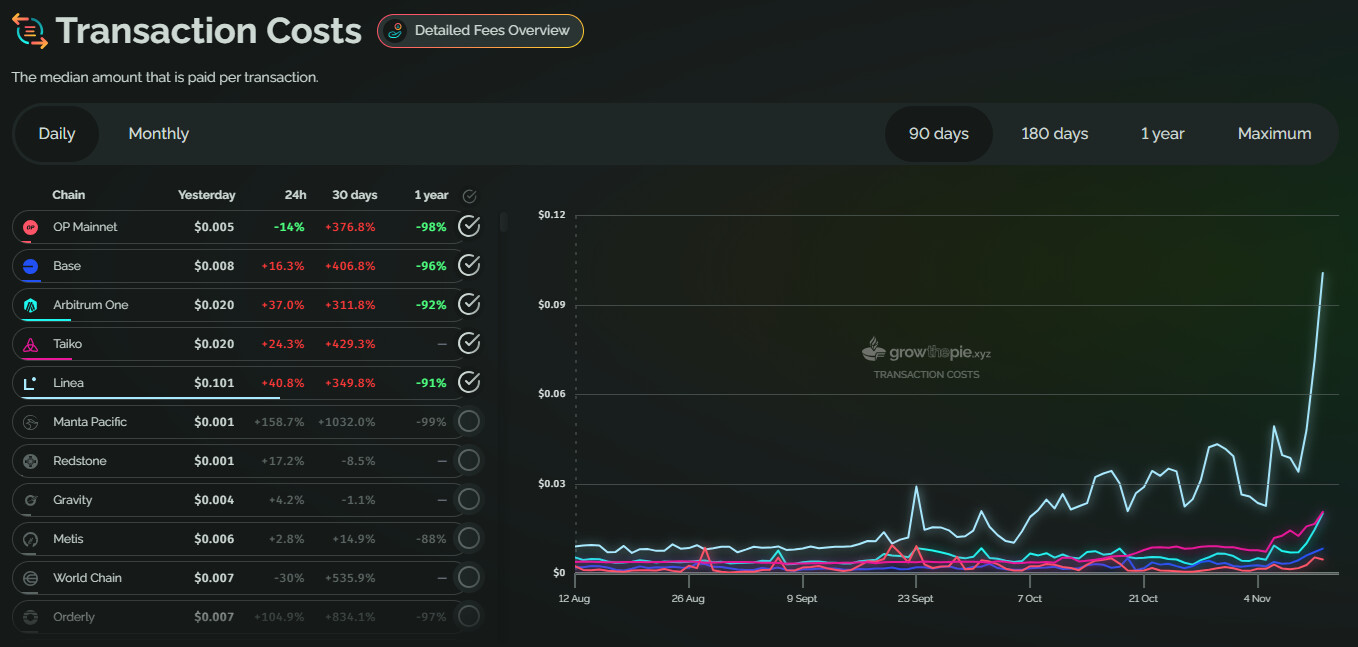L2 chains are waking up – demanding the highest fees in the last three months. None of the L2 chains are offering their usual negligibly cheap transactions under $0.01, and all the leading chains are competing for posts on Ethereum.
Fees for leading L2 chains are catching up with the market frenzy. After months of nearly negligible fees, all major L2 chains have increased transaction fees, which they pass on to end users.
L2 transactions are still reasonable, especially considering the recent spike gas rates on Ethereum. Yet even chains like Base, which pride themselves on very low rates, have seen a significant increase. For high-frequency users and for more complex tasks, even the relatively scalable L2 can increase costs.

Arbitrage fees increased based on stablecoin inflows and increased demand for DEX and DeFi activity. | Source: Growthepie
Optimism fees rose to $0.09, the same as Arbitrum, with higher rates for priority fees. The exact fees may vary at any time, but in recent weeks virtually free transactions came to an end. The blobs went up in October and November target levels more often, creating competitive prices for apps, chains and contracts to access block space.
The biggest change is for Arbitrum, which is going through a bigger change DeFi reawakening under the guidance of Aave V3 loans. The Arbitrum L2 chain is the most widely used because of its speed and low cost. Arbitrum also attracted additional USDT activity, allowing for more active trades. As a result, arbitrage fees saw the largest shift in the short term.
L2 chains also started paying higher fees to Ethereum, with Taiko still the leader. In the past week, L1 costs have increased five to six times for most chains, with virtually no free blob posts left.
In addition to the well-known chains, unknown blob posters also used L1 to secure their final status, further limiting blob space. As the number of small L2 companies has grown to over 100, any increase in activity could lead to an even more competitive blob market.
Over the past week, the blobs started filling up faster, creating competition between chains. The L2 only partially solved the problem by placing fewer blobs, but this did not work in all cases. Base and Taiko kept their usual blob schedule, using the most space and pushing rent up to L1. Despite this, most L2 chains generate significant revenue, still only paying a few thousand dollars in ETH.
ETH fees become prohibitive at the peak of the market
Previously, periods of high fees coincided with airdrop incentives. This time, overall crypto activity is increasing costs across the board. Ethereum is seeing 1.29 million transactions per day, up about 30% in recent days. The increased activity coincided with ETH’s rally above $3,200, with expectations of further gains.
Gas fees on Ethereum are also higher, with regular transactions costing up to $5.72. More complex tasks are once again prohibitively expensive, as DEX swaps cost almost $100 again and NFT sales reach as high as $166.
The rising costs coincide with increased DEX activity, especially after several Ethereum-based tokens experienced a price increase. However, realizing profits through a DEX has increased costs in addition to the demand for early-stage meme token sniping.
Ethereum hasn’t seen such a usage frenzy since the Dencun upgrade in March, which delivered months of negligible fees for both L2 and L1. The resulting ETH burns decreased inflation on the network to just 0.12%, the lowest level in months. As a result, Ethereum is adding approximately 2,800 new ETH per week, instead of over 16,000 ETH as in recent months. At this rate of increased burn, Ethereum still has a chance to return to a deflationary structure, or at least keep its supply lower.
Ethereum base fees are the highest in the last 30 days. However, ETH is still relatively cheap for L2 chains and apps, ranging up to a few thousand dollars per day. Ethereum as L1 remains difficult to scale, with prohibitive fees rising within hours as activity grows.

